Yuxuan Xiong
HPR3D: Hierarchical Proxy Representation for High-Fidelity 3D Reconstruction and Controllable Editing
Jul 16, 2025Abstract:Current 3D representations like meshes, voxels, point clouds, and NeRF-based neural implicit fields exhibit significant limitations: they are often task-specific, lacking universal applicability across reconstruction, generation, editing, and driving. While meshes offer high precision, their dense vertex data complicates editing; NeRFs deliver excellent rendering but suffer from structural ambiguity, hindering animation and manipulation; all representations inherently struggle with the trade-off between data complexity and fidelity. To overcome these issues, we introduce a novel 3D Hierarchical Proxy Node representation. Its core innovation lies in representing an object's shape and texture via a sparse set of hierarchically organized (tree-structured) proxy nodes distributed on its surface and interior. Each node stores local shape and texture information (implicitly encoded by a small MLP) within its neighborhood. Querying any 3D coordinate's properties involves efficient neural interpolation and lightweight decoding from relevant nearby and parent nodes. This framework yields a highly compact representation where nodes align with local semantics, enabling direct drag-and-edit manipulation, and offers scalable quality-complexity control. Extensive experiments across 3D reconstruction and editing demonstrate our method's expressive efficiency, high-fidelity rendering quality, and superior editability.
LiftFeat: 3D Geometry-Aware Local Feature Matching
May 06, 2025Abstract:Robust and efficient local feature matching plays a crucial role in applications such as SLAM and visual localization for robotics. Despite great progress, it is still very challenging to extract robust and discriminative visual features in scenarios with drastic lighting changes, low texture areas, or repetitive patterns. In this paper, we propose a new lightweight network called \textit{LiftFeat}, which lifts the robustness of raw descriptor by aggregating 3D geometric feature. Specifically, we first adopt a pre-trained monocular depth estimation model to generate pseudo surface normal label, supervising the extraction of 3D geometric feature in terms of predicted surface normal. We then design a 3D geometry-aware feature lifting module to fuse surface normal feature with raw 2D descriptor feature. Integrating such 3D geometric feature enhances the discriminative ability of 2D feature description in extreme conditions. Extensive experimental results on relative pose estimation, homography estimation, and visual localization tasks, demonstrate that our LiftFeat outperforms some lightweight state-of-the-art methods. Code will be released at : https://github.com/lyp-deeplearning/LiftFeat.
LLM Sensitivity Evaluation Framework for Clinical Diagnosis
Apr 18, 2025Abstract:Large language models (LLMs) have demonstrated impressive performance across various domains. However, for clinical diagnosis, higher expectations are required for LLM's reliability and sensitivity: thinking like physicians and remaining sensitive to key medical information that affects diagnostic reasoning, as subtle variations can lead to different diagnosis results. Yet, existing works focus mainly on investigating the sensitivity of LLMs to irrelevant context and overlook the importance of key information. In this paper, we investigate the sensitivity of LLMs, i.e. GPT-3.5, GPT-4, Gemini, Claude3 and LLaMA2-7b, to key medical information by introducing different perturbation strategies. The evaluation results highlight the limitations of current LLMs in remaining sensitive to key medical information for diagnostic decision-making. The evolution of LLMs must focus on improving their reliability, enhancing their ability to be sensitive to key information, and effectively utilizing this information. These improvements will enhance human trust in LLMs and facilitate their practical application in real-world scenarios. Our code and dataset are available at https://github.com/chenwei23333/DiagnosisQA.
DualNeRF: Text-Driven 3D Scene Editing via Dual-Field Representation
Feb 22, 2025



Abstract:Recently, denoising diffusion models have achieved promising results in 2D image generation and editing. Instruct-NeRF2NeRF (IN2N) introduces the success of diffusion into 3D scene editing through an "Iterative dataset update" (IDU) strategy. Though achieving fascinating results, IN2N suffers from problems of blurry backgrounds and trapping in local optima. The first problem is caused by IN2N's lack of efficient guidance for background maintenance, while the second stems from the interaction between image editing and NeRF training during IDU. In this work, we introduce DualNeRF to deal with these problems. We propose a dual-field representation to preserve features of the original scene and utilize them as additional guidance to the model for background maintenance during IDU. Moreover, a simulated annealing strategy is embedded into IDU to endow our model with the power of addressing local optima issues. A CLIP-based consistency indicator is used to further improve the editing quality by filtering out low-quality edits. Extensive experiments demonstrate that our method outperforms previous methods both qualitatively and quantitatively.
USR: Unsupervised Separated 3D Garment and Human Reconstruction via Geometry and Semantic Consistency
Mar 02, 2023



Abstract:Dressed people reconstruction from images is a popular task with promising applications in the creative media and game industry. However, most existing methods reconstruct the human body and garments as a whole with the supervision of 3D models, which hinders the downstream interaction tasks and requires hard-to-obtain data. To address these issues, we propose an unsupervised separated 3D garments and human reconstruction model (USR), which reconstructs the human body and authentic textured clothes in layers without 3D models. More specifically, our method proposes a generalized surface-aware neural radiance field to learn the mapping between sparse multi-view images and geometries of the dressed people. Based on the full geometry, we introduce a Semantic and Confidence Guided Separation strategy (SCGS) to detect, segment, and reconstruct the clothes layer, leveraging the consistency between 2D semantic and 3D geometry. Moreover, we propose a Geometry Fine-tune Module to smooth edges. Extensive experiments on our dataset show that comparing with state-of-the-art methods, USR achieves improvements on both geometry and appearance reconstruction while supporting generalizing to unseen people in real time. Besides, we also introduce SMPL-D model to show the benefit of the separated modeling of clothes and the human body that allows swapping clothes and virtual try-on.
Variational Gaussian Topic Model with Invertible Neural Projections
May 21, 2021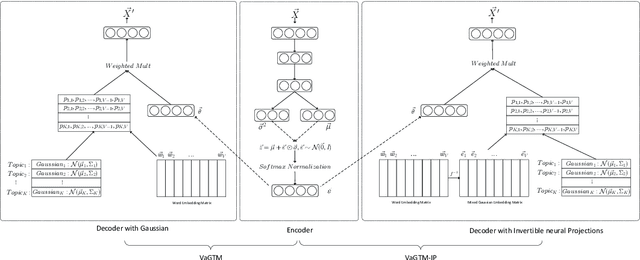

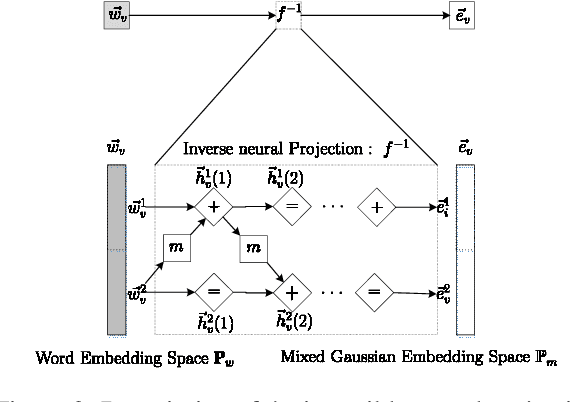
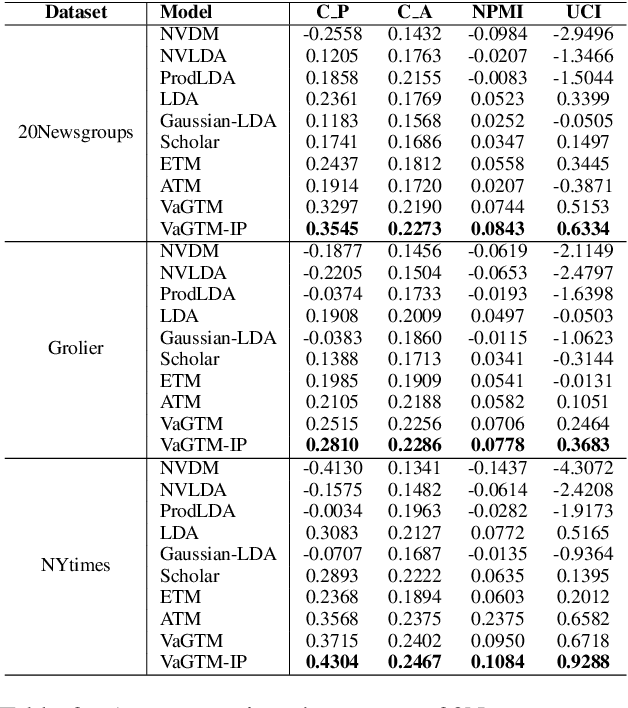
Abstract:Neural topic models have triggered a surge of interest in extracting topics from text automatically since they avoid the sophisticated derivations in conventional topic models. However, scarce neural topic models incorporate the word relatedness information captured in word embedding into the modeling process. To address this issue, we propose a novel topic modeling approach, called Variational Gaussian Topic Model (VaGTM). Based on the variational auto-encoder, the proposed VaGTM models each topic with a multivariate Gaussian in decoder to incorporate word relatedness. Furthermore, to address the limitation that pre-trained word embeddings of topic-associated words do not follow a multivariate Gaussian, Variational Gaussian Topic Model with Invertible neural Projections (VaGTM-IP) is extended from VaGTM. Three benchmark text corpora are used in experiments to verify the effectiveness of VaGTM and VaGTM-IP. The experimental results show that VaGTM and VaGTM-IP outperform several competitive baselines and obtain more coherent topics.
WebSRC: A Dataset for Web-Based Structural Reading Comprehension
Jan 23, 2021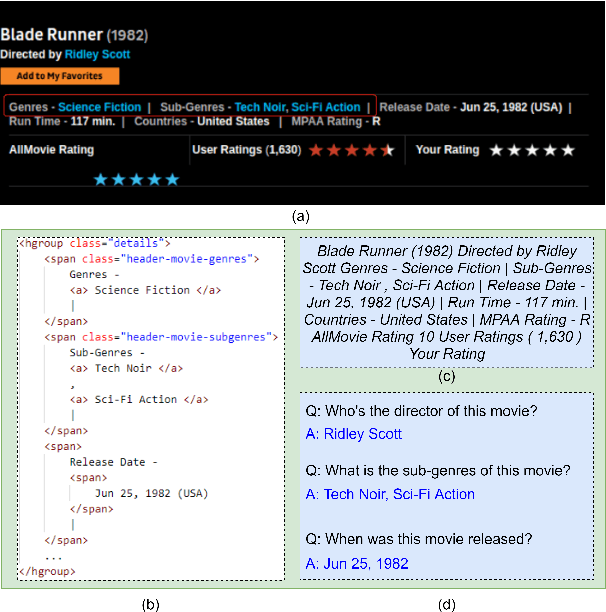

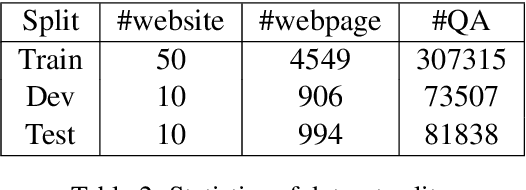

Abstract:Web search is an essential way for human to obtain information, but it's still a great challenge for machines to understand the contents of web pages. In this paper, we introduce the task of web-based structural reading comprehension. Given a web page and a question about it, the task is to find an answer from the web page. This task requires a system not only to understand the semantics of texts but also the structure of the web page. Moreover, we proposed WebSRC, a novel Web-based Structural Reading Comprehension dataset. WebSRC consists of 0.44M question-answer pairs, which are collected from 6.5K web pages with corresponding HTML source code, screenshots, and metadata. Each question in WebSRC requires a certain structural understanding of a web page to answer, and the answer is either a text span on the web page or yes/no. We evaluate various strong baselines on our dataset to show the difficulty of our task. We also investigate the usefulness of structural information and visual features. Our dataset and task are publicly available at https://speechlab-sjtu.github.io/WebSRC/.
Neural Topic Modeling with Cycle-Consistent Adversarial Training
Sep 29, 2020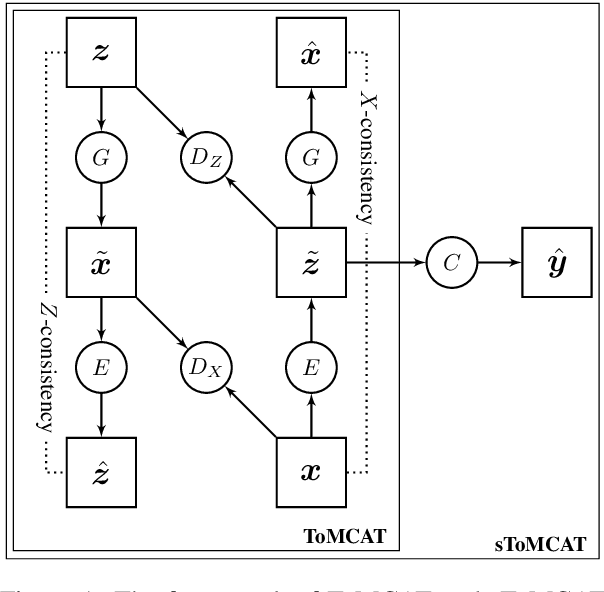
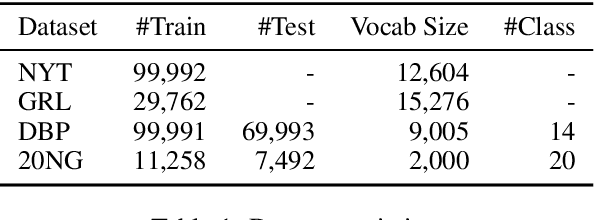
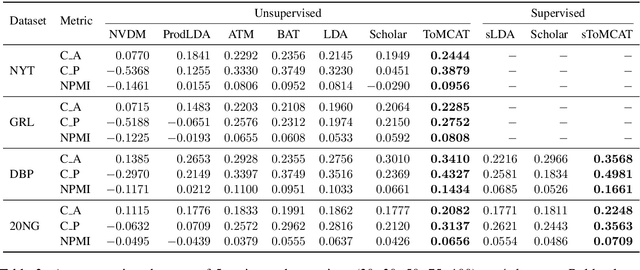
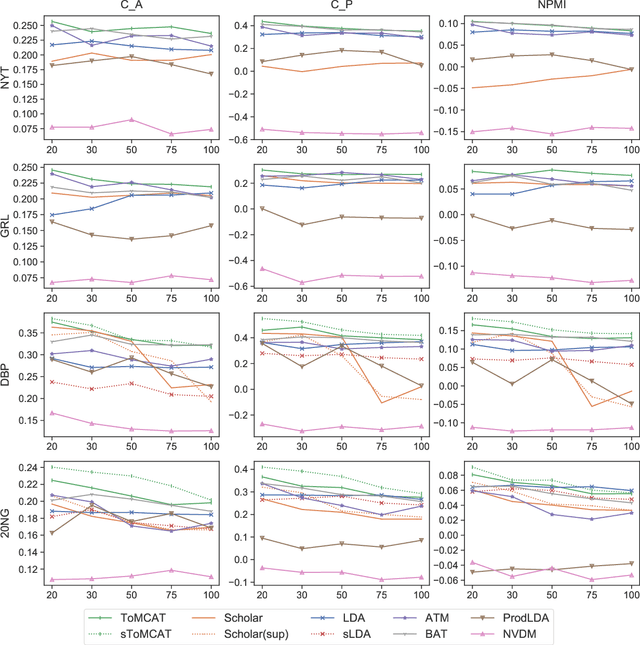
Abstract:Advances on deep generative models have attracted significant research interest in neural topic modeling. The recently proposed Adversarial-neural Topic Model models topics with an adversarially trained generator network and employs Dirichlet prior to capture the semantic patterns in latent topics. It is effective in discovering coherent topics but unable to infer topic distributions for given documents or utilize available document labels. To overcome such limitations, we propose Topic Modeling with Cycle-consistent Adversarial Training (ToMCAT) and its supervised version sToMCAT. ToMCAT employs a generator network to interpret topics and an encoder network to infer document topics. Adversarial training and cycle-consistent constraints are used to encourage the generator and the encoder to produce realistic samples that coordinate with each other. sToMCAT extends ToMCAT by incorporating document labels into the topic modeling process to help discover more coherent topics. The effectiveness of the proposed models is evaluated on unsupervised/supervised topic modeling and text classification. The experimental results show that our models can produce both coherent and informative topics, outperforming a number of competitive baselines.
Neural Topic Modeling with Bidirectional Adversarial Training
Apr 26, 2020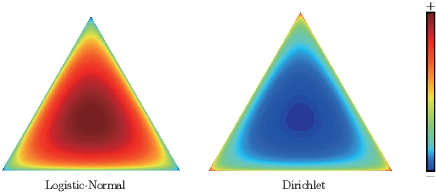


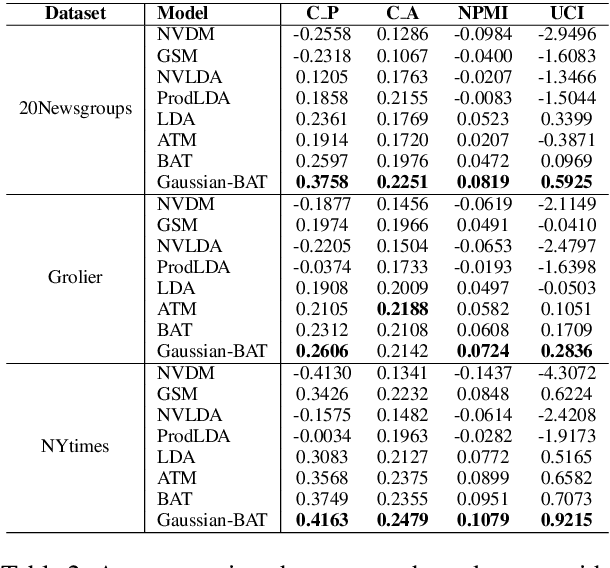
Abstract:Recent years have witnessed a surge of interests of using neural topic models for automatic topic extraction from text, since they avoid the complicated mathematical derivations for model inference as in traditional topic models such as Latent Dirichlet Allocation (LDA). However, these models either typically assume improper prior (e.g. Gaussian or Logistic Normal) over latent topic space or could not infer topic distribution for a given document. To address these limitations, we propose a neural topic modeling approach, called Bidirectional Adversarial Topic (BAT) model, which represents the first attempt of applying bidirectional adversarial training for neural topic modeling. The proposed BAT builds a two-way projection between the document-topic distribution and the document-word distribution. It uses a generator to capture the semantic patterns from texts and an encoder for topic inference. Furthermore, to incorporate word relatedness information, the Bidirectional Adversarial Topic model with Gaussian (Gaussian-BAT) is extended from BAT. To verify the effectiveness of BAT and Gaussian-BAT, three benchmark corpora are used in our experiments. The experimental results show that BAT and Gaussian-BAT obtain more coherent topics, outperforming several competitive baselines. Moreover, when performing text clustering based on the extracted topics, our models outperform all the baselines, with more significant improvements achieved by Gaussian-BAT where an increase of near 6\% is observed in accuracy.
 Add to Chrome
Add to Chrome Add to Firefox
Add to Firefox Add to Edge
Add to Edge